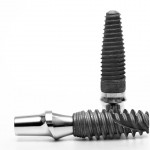
The aim of this review was to compare, the success rate of dental implants placed simultaneously or as a second surgery following ridge augmentation by means of guided bone regeneration (GBR) or onlay graft regeneration technique.
Searches were conducted in Medline and Embase and screening conducted independently by two reviewers. Both prospective and retrospective study designs were considered. Only English language studies were included. A qualitative summary was presented.
- 13 studies were included, 2 ‘randomised’ prospective studies, 1 prospective controlled study, 9 case series and 1 retrospective study.
- 6 studies provided data on simultaneous (immediate) positioning of implants, 5 studies on delayed positioning, and 2 studies provided data on both of these approaches.
- Success rates for implants placed using a simultaneous approach ranged from 61.5% to 100%; success rates for implants placed using a staged approach ranged from 75% to 98%.
The authors concluded
The present systematic review found, on average, poor methodological quality of a limited number of articles focusing on the topic. None was an RCT, which is considered to be the most appropriate type of study to test the effectiveness of interventions, because this type is less prone to the effect of bias. Within the limits of these findings the following conclusions can be drawn: from a clinical point of view, delayed positioning of implants in GBR or onlay grafted areas should be considered more predict- able than immediate positioning.
Comment
As noted by the authors the quality of the identified studies was poor and highlight the need for better quality study designs in order to provide useful answers.
The recently updated Cochrane review by Esposito et al 2013 (see Dental Elf 10th April) looked at the different loading times for dental implants more generally randomised controlled trials. They noted,
Overall there was no convincing evidence of a clinically important difference in prosthesis failure, implant failure, or bone loss associated with different loading times of implants. The quality of the evidence is assessed as very low due to high and unclear risk of bias of primary studies and there is some evidence of reporting bias so clinicians should treat these findings with caution.
The Cochrane search was broader and involved more databases that this current review and was not restricted to English. Of the 45 randomised controlled trials included none were in augmented alveolar bone. Augmentation was not a specific exclusion criteria for inclusion in the review.
A 2010 Cochrane review by Esposito et al did look at the augmentation techniques prior to implant placement identifying 13 RCTs 3 covering horizontal and 10 vertical augmentation, their conclusions were,
.. based on few trials including few patients, sometimes having short follow-up, and often being judged to be at high risk of bias. Various techniques can augment bone horizontally and vertically, but it is unclear which are the most efficient. Short implants appear to be a better alternative to vertical bone grafting of resorbed mandibles. Complications, especially for vertical augmentation, are common. Some bone substitutes could be a preferable alternative to autogenous bone. Osteodistraction osteogenesis allows for more vertical bone augmentation than other techniques which on the other hand can allow for horizontal augmentation at the same time. Titanium screws may be preferable to resorbable screws to fixate onlay bone grafts.
Links
Clementini M, Morlupi A, Agrestini C, Barlattani A. Immediate versus delayed positioning of dental implants in guided bone regeneration or onlay graft regenerated areas: a systematic review. Int J Oral Maxillofac Surg. 2013 May;42(5):643-50. doi: 10.1016/j.ijom.2013.01.018. Epub 2013 Mar 6. PubMed PMID: 23481543.
Esposito M, Grusovin MG, Felice P, Karatzopoulos G, Worthington HV, Coulthard P. Interventions for replacing missing teeth: horizontal and vertical bone augmentation techniques for dental implant treatment. Cochrane Database of Systematic Reviews 2009, Issue 4. Art. No.: CD003607. DOI: 10.1002/14651858.CD003607.pub4.
